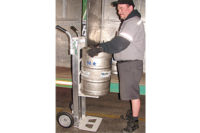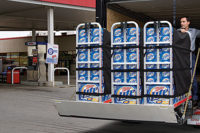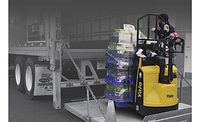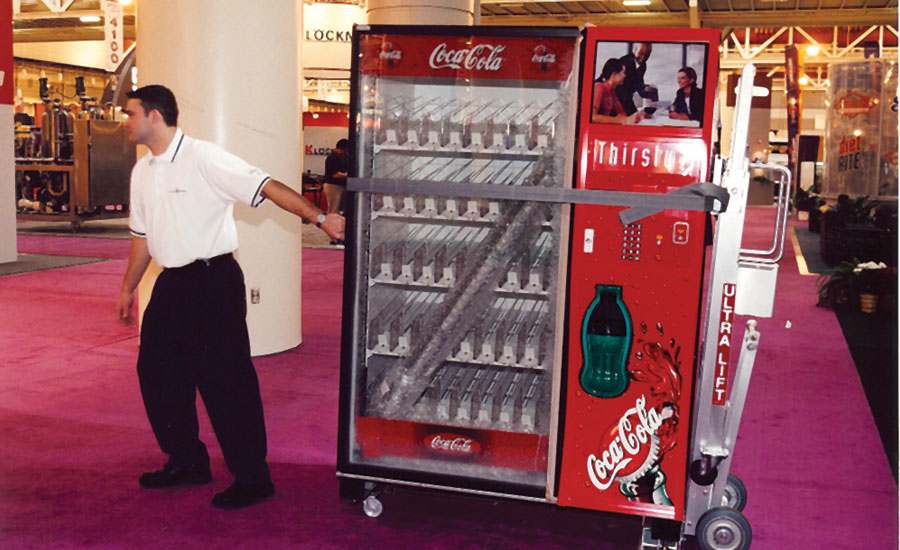Carts and hand truck designs offer ergonomic benefits
Material-handling companies explore options for large and small loads

Magline Inc.’s Self-Stabilizing Hand Truck line features two larger rear wheels and two smaller Magliner Rotacaster wheels by the nose plate to help balance and support the load, requiring limited operator effort, the company says. (Image courtesy of Magline Inc.)

Ultra Lift’s powered hand trucks for handling vending machines includes a power switch that allows the operator to initiate and control motorized lifting, leverage and balance of the vending machine load, reducing operator effort. (Image courtesy of Ultra Lift Corp.)


Beverage route drivers endure one of the most physically demanding jobs in the delivery industry, according to Carl Boettcher, chief executive officer and founder of HTS Systems Lock N Roll LLC, Scranton, Pa. “Pulling a full half-keg of beer from a cellar basement [and] up two flights of stairs is no picnic for anyone,” he points out. On top of the load-bearing requirements of the job, beverage delivery personnel also have to work to stay on schedule, which can sometimes mean rushing without stopping to think about proper lifting ergonomics, he notes.
“When drivers rush quickly or attempt to make up lost route time, they often make mistakes while hurrying,” Boettcher says. “Most back injuries are caused by acting first, without thinking. Just twisting a heavy load or lifting quickly the wrong way can put you in the hospital for days.”
"To protect beverage delivery personnel, the carts and hand trucks industry focuses on ergonomics to meet the safety needs of its customers, notes Andrea Horner, vice president of marketing at Magline Inc., Standish, Mich. “Companies want to keep their workforce strong by working smarter, not harder,” she says. “The well-being and quality of life are important, and Magliner equipment, like the Self-Stabilizing Hand Truck, helps alleviate heavy loads by managing the load instead of the driver.”
Magline introduced its Self-Stabilizing Hand Truck line last fall to meet the ergonomic needs of delivery personnel, according to Horner. The hand trucks feature two larger rear wheels and two smaller Magliner Rotacaster wheels by the nose plate to help balance and support the load, requiring limited operator effort, the company says. This wheel configuration also enables better maneuverability, especially in tight spaces, and makes it easier to navigate obstacles and curbs in a forward, rather than reverse, motion, it says.
When compared with traditional hand trucks, the Self-Stabilizing Hand Truck models require 59 percent less break-back effort, 32 percent less break-back bending, 78 percent less effort negotiating curbs, 67 percent less effort negotiating doors, 62 percent less effort negotiating obstacles, and 43 percent less effort in confined spaces, the company says. They also enable the operator to negotiate curbs and navigate doors 41 percent faster, it adds.
In addition to design attributes like these, a cart or hand truck’s material makeup can be an important ergonomic factor as well. “Magliner equipment is manufactured using durable, yet lightweight aluminum components that offer the highest strength-to-weight ratio,” Horner says. “This means the equipment weighs less to reduce fatigue but is industrial-grade to handle the toughest jobs on a daily basis.”
HTS Systems’ Boettcher notes that these types of cart and hand truck constructions are most applicable to the operational and ergonomic needs of the beverage industry. When choosing a hand truck, he recommends seeking the equipment with the strongest, most-rigid and lightweight frames. “Do the twist test; turn the hand truck around, stand on the nose plate, grab the loop handle or bicycle hand grips and attempt to twist the frame,” he advises for evaluating the delivery equipment. “Where there is movement, there is fatigue, wear and failure.”
Power up
A power component also can make a hand truck operator’s work easier, notes George Dabb, president of Ultra Lift Corp. The San Jose, Calif.-based company offers powered hand trucks for maneuvering some of the heaviest of beverage loads: vending machines. For example, with its Ultra Lift Model 1500 Powered Hand Truck, the operator can use a power switch to initiate and control motorized lifting, leverage and balance of the vending machine load to reduce operator effort and improve control, he says.
Because a powered lift handles the load for the operator, back strains and other injuries are virtually eliminated with this equipment, Dabb notes. In addition, the powered control offers gentle handling of the loads, eliminating bumps, bounces and damage to the load or the area around the hand truck, he points out.
Beyond safety advantages, the powered aspect also provides some productivity perks, Dabb says. “One person with an Ultra Lift can safely handle loads that typically require two people on a manual basis,” he explains. “Two people with an Ultra Lift can often handle loads that typically require three or four people manually.”
Productivity parameters
Productivity is one of the main benefits of working with carts and hand trucks, Magline’s Horner notes. “Using material-handling equipment versus manual handling, whether it be standard two-wheel carts, convertible carts or bulk delivery equipment, reduces the amount of trips and time it takes to deliver product from the truck to the store,” she says.
To make operations even more productive, material-handling companies are exploring different-sized carts and hand trucks to meet different load-size needs. “For bulk orders, many companies are moving away from side-bay trucks to end-load trailers in order to use six-wheel carts like the Magliner Industrial Bulk Truck or CooLift Delivery System,” Magline’s Horner says. “Bulk deliveries reduce product touches and time to check in, allowing more deliveries per day with less trips between truck and store.”
However, as retailers trend toward smaller store sizes and, in turn, smaller inventory deliveries, distribution companies are seeking smaller equipment to help them scale down to efficiently meet these delivery requirements, says Andrea Nottestad, market manager of retail supply chain for Orbis Corp., Oconomowoc, Wis.
“Nearly 60 percent of stores opened in the next five years will be small format,” Nottestad says. “With this growth, beverage companies are looking for ways to reduce unloading time and speed up merchandising time in these smaller stores that typically have narrow doors and no receiving docks. … Any solution that can minimize touches allows drivers and store employees to optimize the delivery and merchandising process.”
At ProMat 2015, which took place March 23-26 in Chicago, the company highlighted its new small-format delivery solutions, including its pally-mobile pallet, which features built-in wheels for wheeling around stores and maneuvering in tight spaces. For added safety, the wheels can be locked for security when handling on a forklift or storing in a trailer.
For efficient and safe storage of carts and hand trucks during travel between retailer stops, HTS Systems offers variations of its Hand Truck Sentry System to accommodate most commercial hand trucks used in the beverage industry, Boettcher says. The system attaches to the front or back of a delivery truck and allows the delivery operator to quickly store the hand truck in a place that does not take up additional cargo space, he explains.
Inside the cab, the system includes an electrical release system on the dashboard so that the driver can trigger the hand truck’s release as he or she is exiting the cab. An LED indicator light and alarm also alert the driver as to whether or not the Hand Truck Sentry System is safely locked, which ensures that the hand truck is securely stowed and not forgotten at a distribution site or lost during transit, the company says.
“Our equipment guarantees safe, fast and easy securement,” Boettcher says. “Anytime that you can make a work task safer, easier and faster, you’ve quantified a payback and a return on your investment. When you can increase valuable cargo space and reduce equipment damage and loss, premature failure, vehicle wear or product damage, you can formulate a risk-reduction assessment and improve a systematic method, [and] then you’re able to create a new methodology process that has considerable value.”
Looking for a reprint of this article?
From high-res PDFs to custom plaques, order your copy today!








